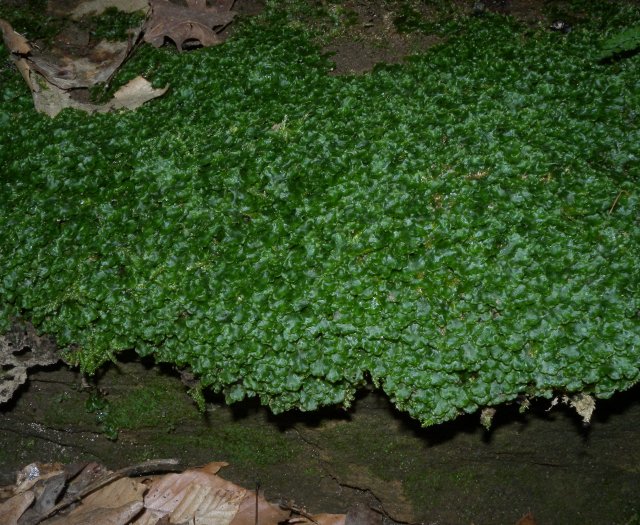
This liverwort is monoecious (or more specifically, paroicous), forming antheridia (male reproductive organs) and archegonia (female sexual organs) on the upper side of a lobed thallus. The archegonia are located a little behind the growing tip of one or more fertile lobes of the thallus; on each fertile lobe, they are inside a flap-like structure (involucre) with a ragged upper margin above its opening. The antheridia are located in small pimple-shaped bumps behind the flap-like structure containing the archegonia on the same lobe. During the summer, the male sperm are released from the antheridia during wet conditions, when they swim toward the archegonia to fertilize their ova. After fertilization occurs, an immature sporophyte is stored within the involucre over the winter. During the spring, this sporophyte pierces through a white-membranous calyptra (protective hood). The mature sporophyte consists of a spore-bearing capsule on a long seta (stalk). The nearly mature capsule is black and globoid in shape, while the seta is 20-50 mm. (¾–2") long, translucent-white, terete, hollow, and more or less erect.
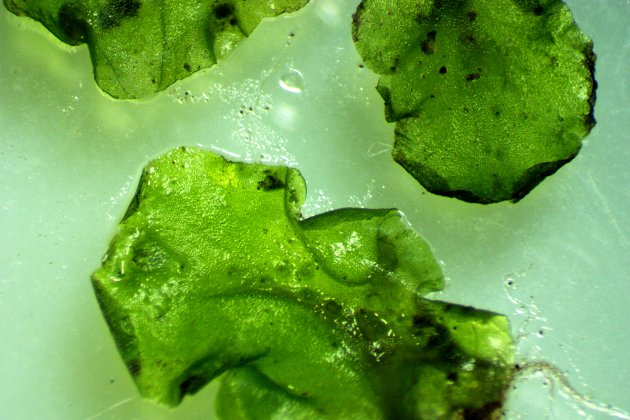
At maturity, the capsule splits open into 4 parts to release its spores to the wind (or they may be carried by water to some extent). In addition to the spores, the capsule contains spring-like elaters (double-spiraled structures) to increase the dispersal of the spores. Individual spores are relatively large (about 100 micrometers long according to some sources) and short-ellipsoid in shape. The sporophyte soon withers away after it releases its spores.
Cultivation: The preference light to medium shade, wet to consistently moist conditions, protection from wind, and an acidic to neutral substrate consisting of rock (e.g., sandstone), clay, or mossy ground. Northern ecotypes of this liverwort are very winter hardy.
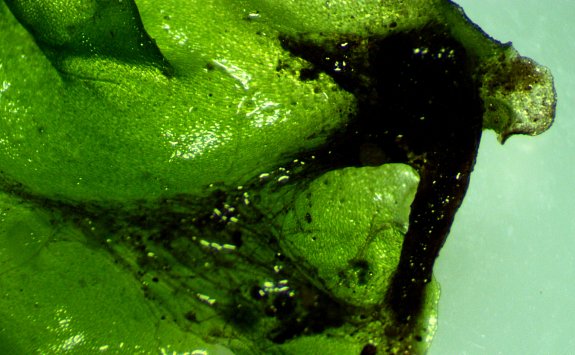
Range & Habitat: Overleaf Pellia (Pellia epiphylla) is uncommon in Illinois, occurring primarily in rocky areas of the southern and north-central sections of the state (see Distribution Map), where it is native. This thalloid liverwort is widely distributed in both North America and Europe. In Illinois, habitats include heavy clay banks along streams, sandstone rocks along creek banks in canyons, moist shaded sandstone walls along streams, north-facing sandstone cliffs, damp shaded rocks in large ravines, sandstone ledges under rocky overhangs, seepage areas at the base of rocky bluffs, wet mossy ground in wooded areas, and plant debris mulch among taller vegetation in marshes. In areas outside of the state, this liverwort sometimes occurs in disturbed areas, but in Illinois it prefers higher quality natural areas.
Faunal Associations: No information on floral-faunal relationships for this liverwort are currently available.
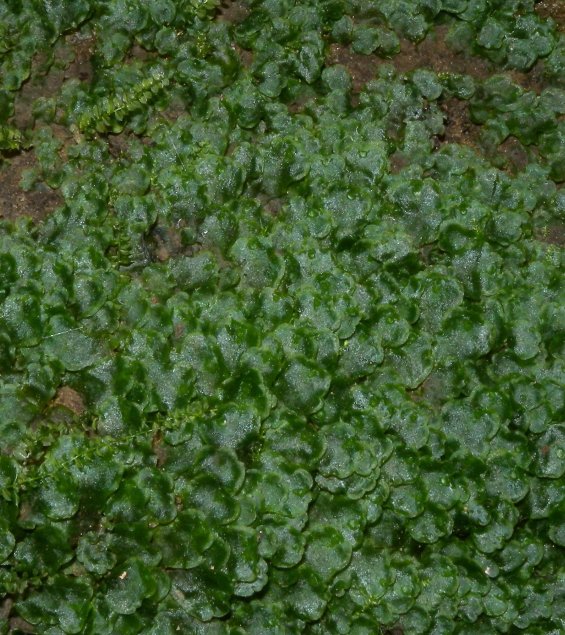
Photographic Location: A sandstone ledge beneath a rocky overhang at the Shades State Park in west-central Indiana. On one of the photos, the flap-like structure containing the female reproductive organs has been circled, while the small pimple-like structures containing the male reproductive organs have arrows pointing to them.
Comments: Because Overleaf Pellia (Pellia epiphylla) looks like several other species of thalloid liverwort, it can be difficult to identify unless the reproductive organs are visible. Unlike other species in this genus, the male and female reproductive organs of Overleaf Pellia are located on the same thallus lobes, rather than on thallus lobes of separate plants. While its reproductive organs are not conspicuous, the flap-like structures containing the archegonia (female sexual organs) and the small pimple-like structures containing the antheridia (male sexual organs) are visible to the naked eye on the upper side of the thallus lobes of this species. If your eyesight is not the best, a 10x hand lens or a magnifying glass can be helpful.
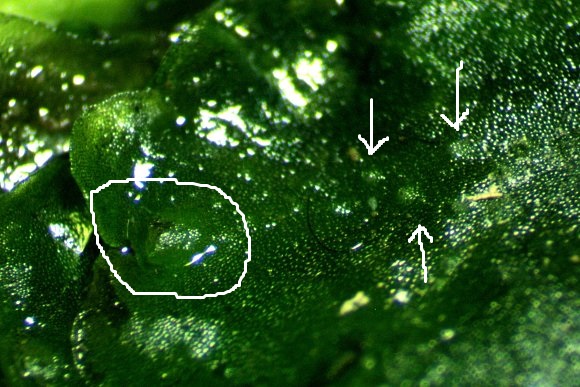
A similar species, Pellia neesiana, has lateral cylindrical structures containing its archegonia on female plants, while the pimple-like structures containing its antheridia on male plants are more abundant and conspicuous. This latter species also tends to have thallus lobes that are more narrow and less branched than those of Overleaf Pellia. There are also similar-looking thalloid liverworts outside of the Pellia genus. This latter group of liverworts can be distinguished by one or more characteristics, including: 1) the differently shaped structures of their male and female reproductive organs, 2) the larger or smaller size of their thallus lobes, 3) the greater presence of purple coloration along the margins and on the undersides of their thallus lobes, even in shade, 4) the absence of scale-like or peg-like rhizoids on the underside of their thallus lobes, 5) the absence of any rhizoids along the margins of the thallus lobes, 6) the more conspicuous midribs of their thallus lobes, and 7) the more conspicuous visibility of the individual cells on the upper surface of their thallus lobes.